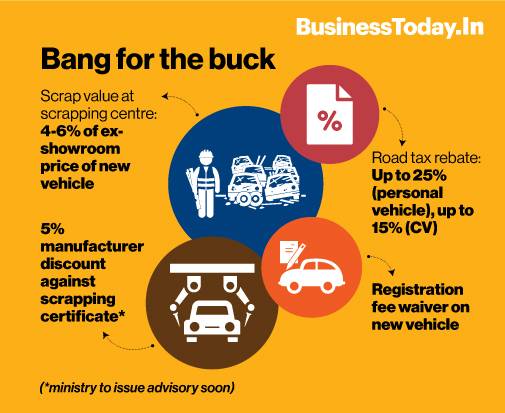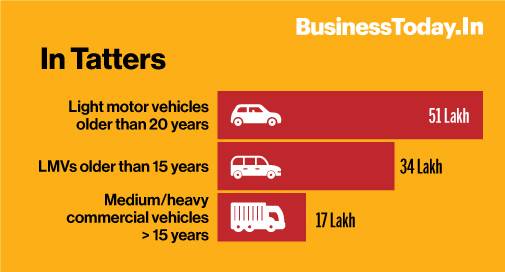New vehicle scrappage policy
2021 AUG 20
Mains >
Environment & Ecology > Pollution > Waste management legislations
IN NEWS:
- Prime Minister Narendra Modi launched the Vehicle Scrappage Policy. The tentative date for the implementation of the policy is October 1, 2021.
BACKGROUND:
- A vehicle scrappage policy was initially announced by the finance minister in the Union Budget 2021-22.
- The objective of the Vehicle Scrappage Policy is to phase out and recycle old vehicles through a systematic process.
FEATURES OF THE POLICY:

- Mandatory fitness test:
- Currently, registration certificate is valid for 15 years for a passenger vehicle and 10 years for a commercial vehicle. The scrappage policy will come into effect after the expiry of this period. The vehicle will then have to undergo a mandatory fitness test.
- Stringent re-registration criteria:
- A vehicle will be declared fit or unfit after conducting multiple tests.
- If a vehicle passes the fitness test, it will get a renewal certificate and would have to undergo a fitness test every five years.
- If it fails, it is declared as ‘end-of-life vehicle’. It will not be permitted for use and owners are given the choice to scrap it.
- Automated testing facilities:
- Vehicles will have to undergo a fitness test at the government registered ‘Automated Fitness Centres’. In the first phase, 75 stations have been proposed to be set up. It will then be scaled up to 450-500 stations across the country.
- Incentives for scrapping:
- Owners who scrap their old vehicle and buy a new one will get incentives as part of the Vehicle Scrappage Policy.
- For eg: Owners of scrapped vehicles will get a scrap value equivalent to 4-6 % of the ex-showroom price of the new vehicle that they would be purchasing. Also, there will be zero registration fees for such new vehicle purchased.
- Disincentives for holding old vehicles:
- Holding on to older vehicles will become expensive, as cost for renewal of fitness certificate will be higher. In addition, states will impose green tax over and above the road tax for older vehicles.
- Exceptions: The policy will not be applicable on vintage cars.
SIGNIFICANCE OF THE POLICY:
- Address pollution:
- According to World Air Quality Report, 22 of the 30 most polluted cities in the world are in India and transportation is among the major sources of air pollution. The scheme aims to cut 25-30 per cent vehicular air pollution and ensure better fuel efficiency.
- Boost automobile industry:
- About 1 crore vehicles more than 15 years old ply on the country’s roads. As the old vehicles will vanish from the road, the service and manufacturing industry will get a boost with an increase in demand for new vehicles.

- Provides a roadmap:
- Numerous individual efforts to scrap old vehicles have been in motion. Eg: Delhi banning diesel vehicles older than 15 years. The national policy will provide a roadmap to these sporadic initiatives.
- Encourage road safety:
- The policy will ensure that more cars on Indian roads are equipped with the rapidly improving safety technologies. Hence, it is in line with the endeavour to reduce road accidents by introducing safety provisions in the Motor Vehicles Act 2019.
- Non coercive and balanced approach:
- The policy aims to nudge owners into compliance through a system of incentives and disincentives. At the same time, it allows the owners of “sentimental” vehicles and collectors of unique automobiles to preserve them, albeit at a price.
- Lead by example by government:
- Government is setting an example by retiring about 2.3 lakh old vehicles owned by various agencies under it.
- ‘Go green’ after COVID-19:
- Vehicle scrappage and replacement is seen as a route to rejuvenate COVID-19-affected economies by privileging green technologies, notably electric vehicles (EVs), and also as an initiative to achieve net zero emissions by mid-century under Paris Agreement commitments.
- Encourage circular economy:
- Scientific scrapping and recycling of parts will help in reusing key materials like steel, plastic and copper. Hence the policy serves as an important link in the circular economy and the waste-to-wealth campaign.
- Eg: India was the world’s second-largest steel scrap importer in 2019. In this scenario, a scrapping policy will encourage cirucular economy, reduce import bill and boost domestic industries.
CONCERNS:
- Shortage of necessary infrastructure:
- Due to lack of a supporting infrastructure, implementation of the scrappage policy will be challenging. Eg: Currently, India has very few automated fitness test centres and scrappage centres, which is inadequate to cater to the market.
- Opposition from trucking industry:
- The country’s trucking industry is opposed to the policy. Industry experts believe the new policy will cause a lot of truck driver-owners to go out of business
- Use of public money:
- Except for the environmental benefit, there is no direct benefit from the policy. Hence, using public money for providing incentives might face opposition.
- Absence of standard operations procedures:
- Absence of clear guidelines on the handling of scraps and recycling of parts by scrapping centres can lead to dumping and new forms of pollution from old vehicles.
- No consideration for distance travelled:
- There are many vehicles which may be over 15 years old, but have not covered that many kilometres. Eg: school and college buses. However, since distance is not considered as a criterion, such vehicles will have to pay hefty price for reregistration.
CONCLUSION:
The fleet modernisation programme of the government is a reassuring testament to the government’s awareness on rising air pollution. Given the well-documented environmental and road safety risks of such large numbers of old automobiles, the policy is a step in the right direction. However, some concerns need to be addressed for the policy to be fully successful.
- Proper recovery: Ecological scrapping, which focuses on high rates of materials recovery, should be the focal area. The scheme should also extend its support to replacing old vehicles with electric ones.
- Create supporting infrastructure: For the proposed policy to succeed, the most important step is to build an infrastructure of testing and scrapping centres quickly across the country.
- Include distance: Along with its age, the distance run by a vehicle should also be included as a criterion.
- Simplify deregistration process: the process to deregister vehicles needs to be simplified so as to encourage people to discard old vehicles.
PRACTICE QUESTION:
Q. The new vehicle scrappage policy is an important link in the circular economy and in the waste to wealth campaign. Discuss?

